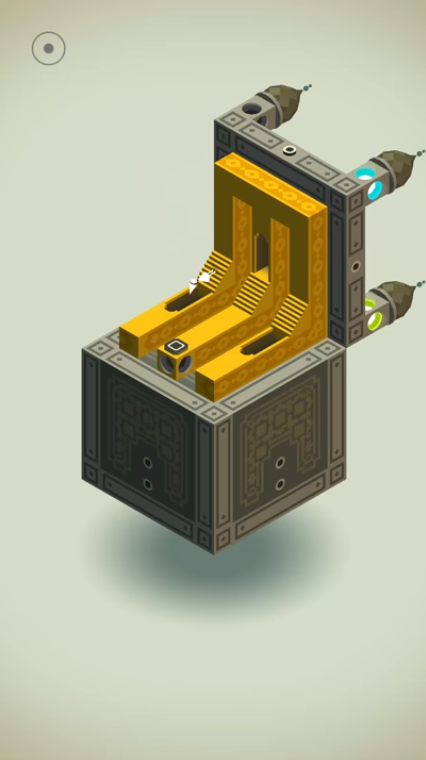Monument Valley is an indie puzzle game made by Ustwo Games. As the player, we take control of Princess Ida, with the objective of navigating across a level to reach a desired platform. This navigation creates unique puzzles focused on manipulating Ida’s movement and her environment. The player has to pass 10 levels, with each level bringing them (and Princess Ida) closer to the end of an implicit narrative of salvation. As a simple puzzle-based narrative game released on mobile platforms like iOS and Android, this game seems to target casual gamers (as well as hardcore puzzle aficionados) who just want to immerse themself in the mystery of this beautiful world for a few hours.
USING EXPLICIT AND IMPLICIT MECHANICS TO CREATE CHALLENGE

Monument Valley’s most interesting mechanic is actually […] its isometric perspective. [This] is what gives the game its challenge, since it becomes hard to judge the depth of items and platforms in this view.
I think Monument Valley’s most interesting mechanic is actually hidden in the game’s visual aesthetic. For me, Monument Valley’s isometric perspective is what gives the game its challenge, since it becomes hard to judge the depth of items and platforms in this view. This view forces players to rethink and reconsider their approach to traverse through a level. Oftentimes, what may seem like an obvious path turns out to not be true because the isometric perspective tricks player into heading towards a platform that’s actually higher than they expected to be. Without this isometric view, Monument Valley might’ve been a completely different game, one much closer to a walking simulator than a puzzle game since the puzzles rely so much on the player’s perspective of the level to be both challenging and rewarding.
EVOKING NARRATIVE THROUGH THOUGHTFUL PUZZLE MACHINERY

The game’s mechanics also help the player craft Ida’s story. In many levels of the game, the player’s perspective literally changes, as the game’s mechanics transition Ida’s movement to be oriented sideways or vertical. This reconfigures the environment and opens up new spaces that the player can tap on to have Ida walk on to. Not only does this new orientation make the game’s puzzles more challenging, it also pushes the player to look at Ida’s character more closely. I found Ida’s resolve to progress through increasingly challenging levels, where the game’s mechanics constantly had me second-guessing my strategies but also left me even more engaged to find a way through, as a reflection of Ida’s state of mind. The increasingly complex levels showcase the path of redemption that Ida is on, a path that is getting harder and harder but also more rewarding at every stage.
…Without the game’s [perspective-changing] mechanics that repeatedly provoke reflection and thought, Ida’s narrative would have been divorced from the puzzle gameplay and created ludo-narrative dissonance.
In fairness, the game’s narrative is also helped tremendously by the world-building: the melancholic soundtrack, Ida’s conversations with the ghosts and the bird-morphing in the end really drives home this story of salvation. But without the game’s mechanics that repeatedly provoke reflection and thought, Ida’s narrative would have been divorced from the puzzle gameplay and created ludo-narrative dissonance.
Overall, the game’s range of interesting mechanics (explicit and implicit) and the way they’re thoughtfully used in new forms in every level elevate its challenge and narrative to create an incredibly fulfilling experience.



